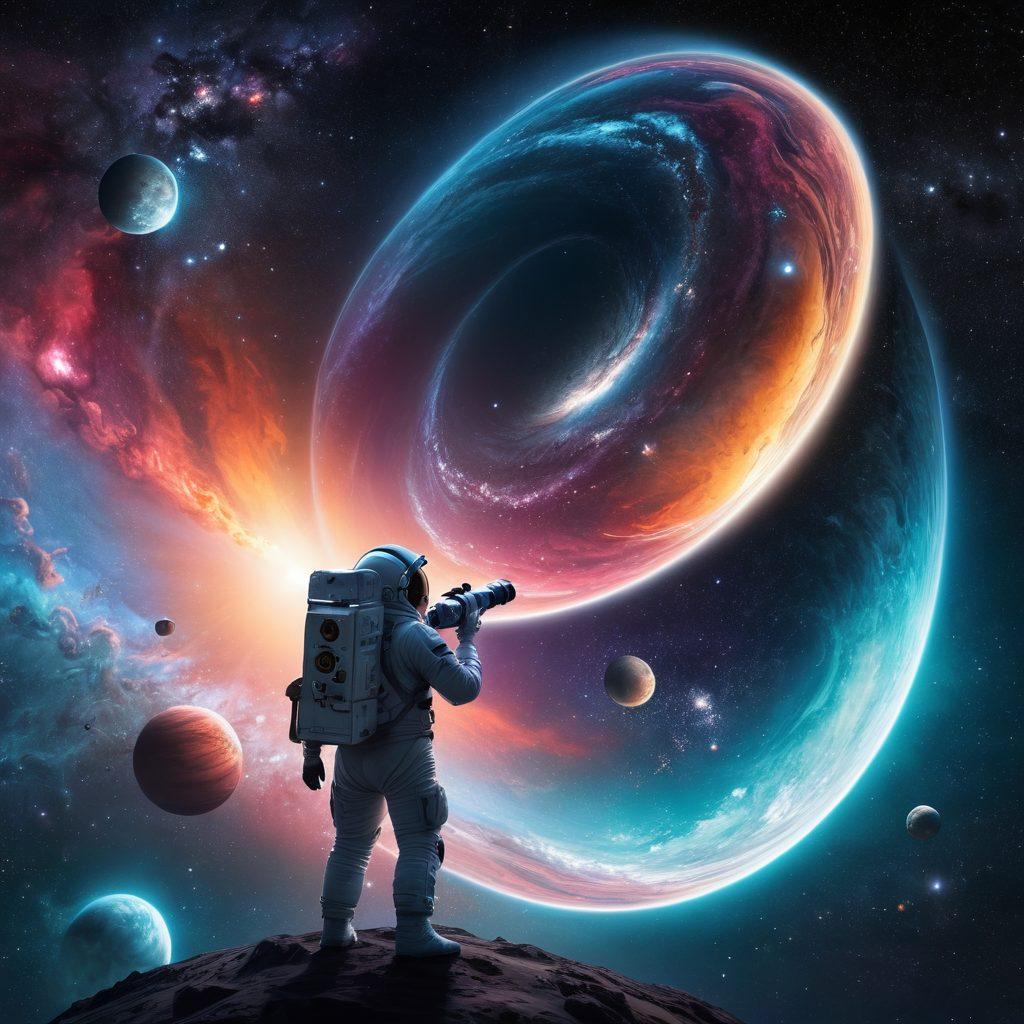Journey Through the Cosmos: Unveiling the Wonders of Astronomy and Beyond
Have you ever gazed up at the night sky and wondered what secrets it holds? The vastness of space is enticing and filled with mysteries that have intrigued humanity for centuries. From the twinkling stars to the enigmatic planets, our journey through the cosmos reveals a tapestry of celestial marvels. In this exploration of astronomy and astrophysics, we'll delve into the intricacies of the universe, uncovering the natural wonders that lie beyond our planet and expanding our understanding of what lies in the great beyond.
Astronomy, the study of celestial bodies, is not just a scientific pursuit; it is a deeply human endeavor. Each star is a beacon enticing us to look closer, while planets like Mars and Jupiter evoke dreams of possibilities and exploration. Imagine standing on the surface of Mars, contemplating its rust-colored deserts, or watching the dance of asteroids in the asteroid belt. The realms of astronautics beckon dreamers and doers alike, as we develop technologies that allow us to venture into this interstellar ballet. Through the lens of space science, we are not only observing the night sky but participating in the unfolding story of the universe.
A fascinating aspect of astronomy is its evolution, marrying art with science. Astrophysics, a branch of astronomy, explains the fundamental interactions that govern celestial bodies. It is crucial to understand these cosmic processes, such as how stars are born, age, and die, to appreciate the celestial fireworks that have been happening for billions of years. “The Cosmos is all that is, or ever was, or ever will be.” Those wise words from Carl Sagan resonate with anyone who has looked up and felt small yet significant in the grand schema of existence. The questions we ponder—Are we alone in the universe? What is dark matter?—fuel both our curiosity and our quest for knowledge.
Astronomy education is vital in nurturing the next generation of astronomers, physicists, and space enthusiasts. Engaging with astroinformatics allows scientists to harness the power of data to explore vast amounts of astronomical information. Think about it: every photograph taken by a telescope contains a wealth of data waiting to be unlocked. For young minds curious about the cosmos, there are countless resources available, from interactive apps to community events, bringing the universe a little closer to home. Engaging in hands-on astronomy research can inspire a future where humanity truly understands the universe’s workings and its potential.
Astrobiology, the study of life in the universe, further elevates our emotional and intellectual connection to the cosmos. As we gather evidence of celestial bodies that harbor conditions suitable for life—think of the icy moons of Jupiter or the potentially habitable exoplanets—our imaginations are set ablaze. What would life on another planet look like? How would it adapt to different conditions? Our quest for knowledge about these orbital neighbors pushes us beyond the realm of simple observation into proactive exploration of the stars. Join us as we continue this journey through astronomy and astrophysics; there are hundreds of thousands of miles left to travel, and countless wonders still await discovery.
From Asteroids to Interstellar Wonders: The Expansive Realm of Space Science
In the grand tapestry of the universe, space science brings together a plethora of enthralling topics, each more mind-boggling than the last. Imagine a realm where asteroids dance in the cosmic ballet, and celestial bodies compose a symphony echoing through time and space. This is the world of astronomy – a field that invites curious minds to unravel the mysteries of the universe and explore the fascinating depths of astrophysics. As we embark on this journey from asteroids to interstellar wonders, prepare for a thrilling exploration of space science that will ignite your imagination and quench your thirst for knowledge.
Asteroids, those remnants from the formation of our solar system, are far more than just flying rocks. Picture them as ancient travelers, carrying with them secrets from billions of years ago. Science has shown that studying these celestial bodies provides valuable insights into the early conditions of our solar system. But what would it be like to hold a piece of these asteroids in your hands? The thought alone enchants aspiring astronautics enthusiasts and fuels the ambitions of ambitious astronomers. After all, understanding our cosmic neighbors is a crucial step in the thrilling adventure of space exploration.
By delving deeper into astronomy and astrophysics, we realize that every discovery leads to more questions. Have you ever gazed up at the stars and pondered what lies beyond them? The cosmos expands further than our telescopes can capture, stretching across interstellar distances that stir our curiosity. Scientists dedicate their lives to answering these questions, utilizing tools like astroinformatics to analyze data from various missions. The pursuit of knowledge in cosmology isn’t just for scientists; it’s an invitation for everyone to engage in the wonders of space through astronomy education programs and community events that can empower you to become a part of this magnificent journey.
What about the enigmatic worlds that orbit distant stars? The realm of astrobiology invites us to ponder whether life exists beyond Earth. Imagine discovering an exoplanet with conditions similar to our own, bustling with potential! This prospect not only teases the scientific community, but it also captivates our collective imagination. How might we communicate with these extraterrestrial civilizations? As we develop our understanding of space science, our dreams of interstellar travel aren't mere fantasies; they're edging closer to reality with every advance in technology and research.
Engaging in space science is not just for researchers but for anyone with a spark of curiosity. Start your exploration by diving into astronomy books, attending local stargazing events, or joining online astronomy classes that emphasize astronomy education. Cultivating a passion for the astral wonders around us can be easily achieved by following scientific updates and participating in discussions about astronomy research. After all, the universe has infinite stories waiting for us to uncover. So, are you ready to embark on this cosmic journey? Your adventure is just a single thought away.
Unlocking the Secrets of the Universe: The Intersection of Astrobiology and Astronomy Education
As we gaze up at the stars, have you ever wondered about the mysteries that lie beyond our planet? The universe is an expansive realm filled with celestial bodies, and at its intersection with life, we find the fields of astrobiology and astronomy. Unlocking the secrets of the universe requires a collaborative approach that marries these two disciplines. The result is not just a deeper understanding of the cosmos but a revelation about our place within it. So, how can we, as explorers of space science, harness the wonders of astronomy education to navigate these astronomical discoveries?
Imagine stepping into the shoes of an astronaut, floating in the vastness of space, gazing upon distant galaxies and shimmering asteroids. This is the thrill of exploration! Astronomy research opens windows to interstellar realms, revealing the complexities of cosmology and the fundamental laws that govern our universe. It's in this grand exploration that we encounter profound questions: What is the likelihood of life on other planets? How do celestial phenomena interact with one another? Engaging the mind through astronomy education equips us with the tools to delve deep into these inquiries.
What's truly captivating about astroinformatics is its ability to process vast amounts of astronomical data, pulling together valuable insights that enhance our understanding of the cosmos. By harnessing advanced technologies, we can analyze light from distant stars and study the chemical compositions of exoplanets. This not only aids astronomy research but also allows aspiring astronauts and astrophysicists to unravel the intricate web of conditions necessary for life to thrive in the universe. Have you thought about how this synergy of education and technology can pave the way for future discoveries?
Participation in astronomical societies and educational programs is vital for anyone looking to enrich their knowledge of space science. Astronomy education has evolved, inviting learners of all ages to engage in the mesmerizing world of the cosmos. Whether it's through planetarium visits, workshops, or online courses, these opportunities spark curiosity about celestial bodies and ignite a passion for exploration. And let's not forget how important it is to share these experiences with others—community-led astronomy clubs often create vibrant discussions around astrophysics and the possible presence of life beyond Earth.
Ultimately, the intersection of astrobiology and astronomy education shapes our understanding of the universe and the potential for extraterrestrial life. As our studies deepen, so does our appreciation for the intricate relationships between cosmic events and the emergence of life. With every new discovery, we inch closer to answering the big questions: Are we alone in this vast universe? What lies beyond our solar system? In the quest for knowledge, embracing the wonders of astronomy entails not just seeking answers but enjoying the intricacies of the journey itself. So let’s embark on this adventure together and unlock the secrets waiting among the stars!


